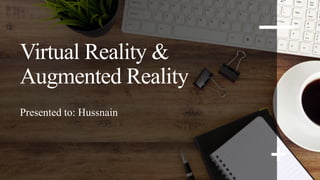Virtual Reality & Augmented Reality.pptx
•
0 likes•19 views
Virtual Reality & Augmented Reality
Report
Share
Report
Share
Download to read offline

Recommended
Recommended
More Related Content
Similar to Virtual Reality & Augmented Reality.pptx
Similar to Virtual Reality & Augmented Reality.pptx (20)
Augmented reality (AR) is an enhanced version of the real physical world

Augmented reality (AR) is an enhanced version of the real physical world
augmented and virtual reality basd on extented reality

augmented and virtual reality basd on extented reality
Recently uploaded
God is a creative God Gen 1:1. All that He created was “good”, could also be translated “beautiful”. God created man in His own image Gen 1:27. Maths helps us discover the beauty that God has created in His world and, in turn, create beautiful designs to serve and enrich the lives of others.
Explore beautiful and ugly buildings. Mathematics helps us create beautiful d...

Explore beautiful and ugly buildings. Mathematics helps us create beautiful d...christianmathematics
Recently uploaded (20)
Unit-IV; Professional Sales Representative (PSR).pptx

Unit-IV; Professional Sales Representative (PSR).pptx
Asian American Pacific Islander Month DDSD 2024.pptx

Asian American Pacific Islander Month DDSD 2024.pptx
ICT role in 21st century education and it's challenges.

ICT role in 21st century education and it's challenges.
Beyond the EU: DORA and NIS 2 Directive's Global Impact

Beyond the EU: DORA and NIS 2 Directive's Global Impact
Explore beautiful and ugly buildings. Mathematics helps us create beautiful d...

Explore beautiful and ugly buildings. Mathematics helps us create beautiful d...
Mixin Classes in Odoo 17 How to Extend Models Using Mixin Classes

Mixin Classes in Odoo 17 How to Extend Models Using Mixin Classes
Ecological Succession. ( ECOSYSTEM, B. Pharmacy, 1st Year, Sem-II, Environmen...

Ecological Succession. ( ECOSYSTEM, B. Pharmacy, 1st Year, Sem-II, Environmen...
On National Teacher Day, meet the 2024-25 Kenan Fellows

On National Teacher Day, meet the 2024-25 Kenan Fellows
Virtual Reality & Augmented Reality.pptx
- 1. Virtual Reality & Augmented Reality Presented to: Hussnain
- 3. 1.What is Virtual Reality Overview 6.Advantages & Disadvantages of Virtual Reality 5.Applications of Virtual Reality 4.Devices used in Virtual Reality 3.Types of Virtual Reality 2.History of Virtual Reality
- 4. What is Virtual Reality? It's a computer-generated simulation of a three-dimensional environment that can be interacted with in a seemingly real or physical way by a person using special electronic equipment, such as a headset with a screen.
- 5. History Of Virtual Reality Virtual reality (VR) originated in the 1960s with early experiments by Ivan Sutherland. After decades of development, the 2010s marked a turning point with the release of Oculus Rift, sparking a resurgence in VR technology. Today, VR continues to advance, finding applications in diverse fields beyond gaming.
- 6. Types Of Virtual Reality 1.Non-immersive VR: Limited immersion, often using traditional screens. 2.Partially Immersive VR: More immersive with devices like VR headsets and motion controllers. 3.Fully Immersive VR: Highest level of immersion, blocking out the real world with headsets and often including additional sensory feedback. There are three main types of virtual reality (VR):
- 7. Devices used in Virtual Reality Virtual Reality (VR) uses devices like headsets, controllers, and sensors to create cool, lifelike experiences. Some devices, like gloves and vests, make it feel like you're touching things. You need a powerful computer for some headsets. AR glasses, like Microsoft HoloLens, mix virtual and real stuff. It's all about making amazing, interactive virtual worlds.
- 8. Applications of Virtual Reality Virtual Reality (VR) is applied in gaming, education for simulations and training, healthcare for therapy and surgery practice, architecture for virtual walkthroughs, corporate training and simulations, and spans industries like tourism, research, art, and sports training.
- 9. Advantages of Virtual Reality 1.Realistic simulations enhance education and training experiences. 2. Provides safe, controlled environments for cost-effective and risk-free training. 3. Offers engaging and interactive gaming and entertainment.
- 10. Disadvantages of Virtual Reality 1.High expenses limit widespread access to quality VR equipment. 3.Over-reliance on VR can contribute to a sense of isolation from the real world. 2.Prolonged use may lead to discomfort, motion sickness, and eye strain.
- 12. 1.What is Augmented Reality Overview 2.History of Augmented Reality 3.Types of Augmented Reality 4.Devices used in Augmented Reality 5.Applications of Augmented Reality 6.Advantages & Disadvantages of Augmented Reality
- 13. What is Augmented Reality Augmented Reality (AR) overlays digital information, such as graphics or data, onto the real-world environment. It enhances user experiences by blending virtual elements with the physical surroundings, often viewed through devices like smartphones or smart glasses.
- 14. History of Augmented Reality Augmented Reality (AR) traces back to Ivan Sutherland's "Sword of Damocles" in the 1960s. Coined in the 1990s, AR gained momentum with smartphone apps in the 2000s and surged in popularity with Pokémon GO in 2016, evolving into a diverse technology with applications across industries today.
- 15. Types Of Augmented Reality Augmented Reality (AR) has two main types: 1.Marker-Based AR: using visual markers like QR codes to trigger digital content. 2.Markerless AR: relying on device sensors for dynamic overlays without predefined markers.
- 16. Devices used in Augmented Reality Augmented Reality (AR) is experienced through devices like smartphones, tablets, and smart glasses, utilizing their cameras and sensors. Smart glasses, such as Microsoft HoloLens and Google Glass. These devices enable users to interact with digital information seamlessly integrated into their real-world surroundings.
- 17. Applications of Augmented Reality Augmented Reality (AR) applications are diverse, enhancing gaming with overlays like Pokémon GO and transforming education through immersive learning simulations. In healthcare, AR aids in surgery planning and medical training, while navigation apps use AR for real-time directions.
- 18. Advantages of Augmented Reality 1.Enhances user experiences by blending digital content with the real world. 2.Facilitates immersive learning, training, and interactive marketing. 3.Improves efficiency in industries with real-time visual guidance and information
- 19. Disadvantages of Augmented Reality 1.Faces technological limitations dependent on device capabilities. 2.Involves high costs for application development and device acquisition. 3.Raises privacy concerns related to data collection and security.
- 20. ANY QUESTION